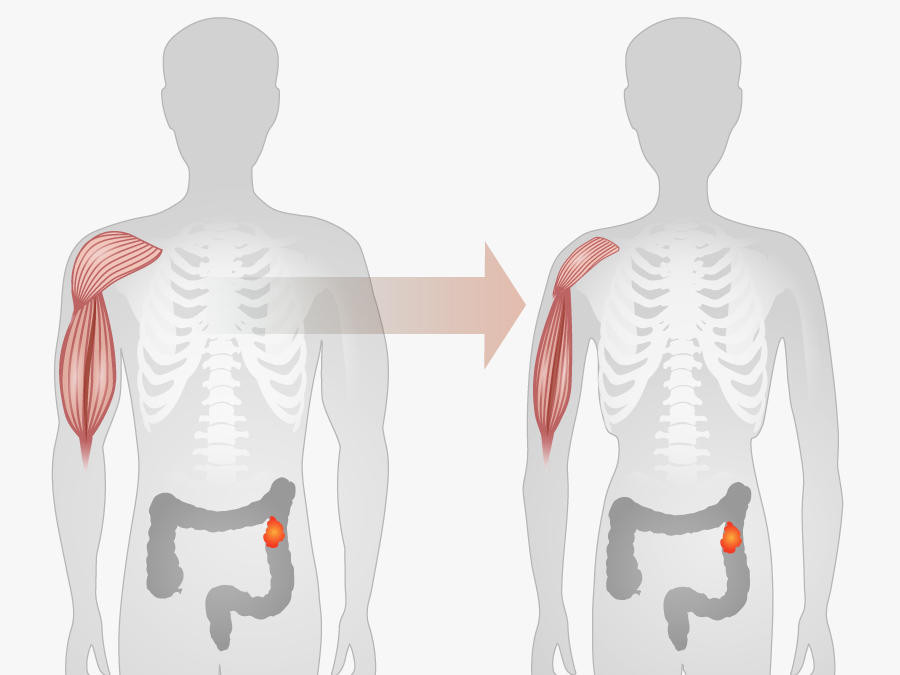What is Cancer Cachexia?
Cancer cachexia is a condition characterized by severe weight loss and muscle wasting that commonly affects patients with advanced cancer. It occurs when the body starts breaking down its own muscle and fat stores for energy. This happens when factors secreted by the tumor create an environment of metabolic imbalance. It often results in physical disability as well as decreased tolerance to anticancer treatments.
Symptoms
Some key symptoms of it include:
- Unintentional weight loss of more than 5% of body weight over the previous 6 months or any amount of weight loss that leads to a BMI of less than 20 kg/m2.
- Reduction in fat and muscle mass throughout the body which gives a skeletal appearance to the patient.
- Loss of appetite or feeling full even after eating small amounts of food.
- Fatigue and generalized weakness due to decreased calorie and protein intake.
- Digestive issues such as nausea, vomiting, diarrhea or constipation.
- Swelling or fluid retention in the legs or abdomen.
- Impaired ability to do daily activities due to loss of muscle strength.
Changes in Metabolism
There are various metabolic changes that occur in the body during cancer cachexia:
- Increased breakdown of skeletal muscle protein through activation of the ubiquitin-proteasome pathway and autophagy. This leads to loss of lean body mass.
- Elevated levels of pro-inflammatory cytokines like tumor necrosis factor-α, interleukin-6 and others produced by the body as well as cancer cells. These promote insulin resistance and lipolysis increasing fat loss.
- Impaired glucose homeostasis resulting from insulin resistance. This causes higher blood glucose and free fatty acid levels.
- Anorexia and early satiety developing due to increased levels of anorexigenic hormones like leptin. Appetite and food intake get suppressed.
- Raised levels of lipid mobilizing factors such as glucocorticoids and catecholamines. They facilitate fat breakdown.
- Disordered energy expenditure with hypermetabolism taking place at rest. This leads to increased calorie requirements despite low food consumption.
Causes and Risk Factors
Some key causes and risk factors for cancer cachexia include:
- Advanced stage cancer that has metastasized or spread to other organs. Lung cancer, upper gastrointestinal cancers and pancreatic cancer have higher association with cachexia.
- Aggressive tumor biology with increased production of cachectic factors from malignant cells.
- Anorexia and inadequate dietary intake failing to meet increased calorie demands of the body and tumor.
- High inflammatory tumor microenvironment stimulating production of cytokines.
- Co-morbid conditions like chronic obstructive pulmonary disease.
- Certain cancer treatments like chemotherapy, radiotherapy and targeted therapies also contribute to cachexia development.
Evaluation and Diagnosis
A thorough medical history and physical examination along with relevant investigations help diagnose cancer cachexia:
- Detailed evaluation of unintended weight loss, muscle wasting, fatigue and functional impairment.
- Assessment of nutritional status through BMI, fat and muscle mass measurements.
- Blood tests to check markers of inflammation, glucose regulation and nutritional deficiencies.
- Imaging studies like CT or MRI scans evaluate tumor burden and stage.
- Exclusion of other potential causes like infections, malabsorption or hyperthyroidism that could mimic cachexia.
- Diagnosis is based on weight loss presence along with biochemical and clinical abnormalities after ruling out other causes.
Management and Treatment Approaches
Currently no universally effective treatment exists with management being multi-pronged:
- Adequate calorie and protein provision through oral nutrition supplements or tube feeding if oral intake is inadequate.
- Appetite stimulants such as corticosteroids or cannabinoids to improve food intake along with anti-nausea medications.
- Exercise therapy involving aerobic and resistance training tailored to individual ability show benefits.
- Pharmaceutical interventions targeting cachectic factors through progestogens, anti-inflammatories have shown variable results.
- Newer biological agents under investigation aim to block specific pathways driving muscle wasting.
- Treating any underlying infections or managing symptomatically is also important along with anticancer treatment.
- Timely palliative and supportive care is crucial in advanced cachectic patients with overall focus on symptom relief.
- A multidisciplinary team approach including oncologists, dietitians and others is recommended.
In conclusion, cancer cachexia is a devastating condition that greatly impacts quality of life. While improvements have been made, significant research is still ongoing to develop novel therapeutic targets aimed at effectively preventing and reversing the metabolic alterations driving cachexia. A multimodal management approach tailored for individual patients remains the mainstay.
About Author:
Ravina Pandya, Content Writer, has a strong foothold in the market research industry. She specializes in writing well-researched articles from different industries, including food and beverages, information and technology, healthcare, chemical and materials, etc. (https://www.linkedin.com/in/ravina-pandya-1a3984191)
*Note:
1. Source: Coherent Market Insights, Public sources, Desk research
2. We have leveraged AI tools to mine information and compile it

